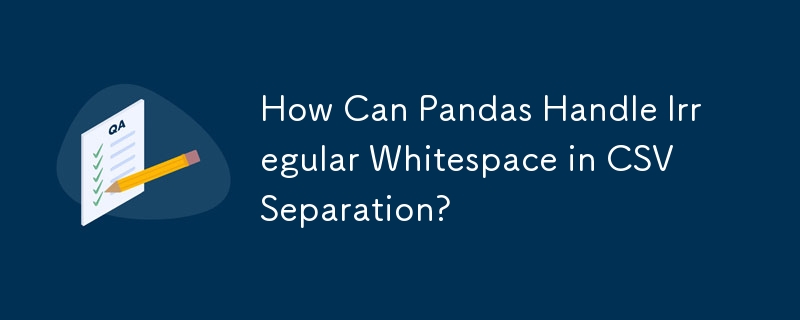 Backend Development
Backend Development
 Python Tutorial
Python Tutorial
 How Can Pandas Handle Irregular Whitespace in CSV Separation?
How Can Pandas Handle Irregular Whitespace in CSV Separation?
How Can Pandas Handle Irregular Whitespace in CSV Separation?

Making CSV Separators More Flexible for Irregular Whitespace in Pandas
When using pandas.read_csv() to create dataframes from files with irregular column separators, encountering challenges is common. Some columns may be separated by tabs, while others are separated by varying numbers of spaces or even a mix of spaces and tabs. This irregularity can lead to parsing issues.
To address this problem, pandas provides two options: using a regular expression (regex) or setting delim_whitespace.
Using a Regular Expression
The regex option allows you to specify a pattern for the separator. For example:
<code class="python">import pandas as pd
df = pd.read_csv("file.csv", header=None, delimiter=r"\s+")</code>Here, r"s " matches one or more whitespace characters (including spaces and tabs).
Using delim_whitespace
The delim_whitespace=True option automatically detects whitespace (spaces and tabs) as separators:
<code class="python">df = pd.read_csv("file.csv", header=None, delim_whitespace=True)</code>Comparison with Python's split() Method
You mentioned that in Python, you can use line.split() to handle variable whitespace without issues. pandas.read_csv() provides similar flexibility through the delim_whitespace and regex options.
Example
Using the following input file (whitespace.csv):
a b c 1 2 d e f 3 4
The following code will create a dataframe with correct column separation, regardless of the separator type:
<code class="python">df = pd.read_csv("whitespace.csv", header=None, delim_whitespace=True)
print(df)
0 1 2 3 4
0 a b c 1 2
1 d e f 3 4</code>The above is the detailed content of How Can Pandas Handle Irregular Whitespace in CSV Separation?. For more information, please follow other related articles on the PHP Chinese website!

Hot AI Tools

Undresser.AI Undress
AI-powered app for creating realistic nude photos

AI Clothes Remover
Online AI tool for removing clothes from photos.

Undress AI Tool
Undress images for free

Clothoff.io
AI clothes remover

AI Hentai Generator
Generate AI Hentai for free.

Hot Article

Hot Tools

Notepad++7.3.1
Easy-to-use and free code editor

SublimeText3 Chinese version
Chinese version, very easy to use

Zend Studio 13.0.1
Powerful PHP integrated development environment

Dreamweaver CS6
Visual web development tools

SublimeText3 Mac version
God-level code editing software (SublimeText3)

Hot Topics
 1377
1377
 52
52
 How to solve the permissions problem encountered when viewing Python version in Linux terminal?
Apr 01, 2025 pm 05:09 PM
How to solve the permissions problem encountered when viewing Python version in Linux terminal?
Apr 01, 2025 pm 05:09 PM
Solution to permission issues when viewing Python version in Linux terminal When you try to view Python version in Linux terminal, enter python...
 How to efficiently copy the entire column of one DataFrame into another DataFrame with different structures in Python?
Apr 01, 2025 pm 11:15 PM
How to efficiently copy the entire column of one DataFrame into another DataFrame with different structures in Python?
Apr 01, 2025 pm 11:15 PM
When using Python's pandas library, how to copy whole columns between two DataFrames with different structures is a common problem. Suppose we have two Dats...
 How to dynamically create an object through a string and call its methods in Python?
Apr 01, 2025 pm 11:18 PM
How to dynamically create an object through a string and call its methods in Python?
Apr 01, 2025 pm 11:18 PM
In Python, how to dynamically create an object through a string and call its methods? This is a common programming requirement, especially if it needs to be configured or run...
 How to teach computer novice programming basics in project and problem-driven methods within 10 hours?
Apr 02, 2025 am 07:18 AM
How to teach computer novice programming basics in project and problem-driven methods within 10 hours?
Apr 02, 2025 am 07:18 AM
How to teach computer novice programming basics within 10 hours? If you only have 10 hours to teach computer novice some programming knowledge, what would you choose to teach...
 How does Uvicorn continuously listen for HTTP requests without serving_forever()?
Apr 01, 2025 pm 10:51 PM
How does Uvicorn continuously listen for HTTP requests without serving_forever()?
Apr 01, 2025 pm 10:51 PM
How does Uvicorn continuously listen for HTTP requests? Uvicorn is a lightweight web server based on ASGI. One of its core functions is to listen for HTTP requests and proceed...
 What are some popular Python libraries and their uses?
Mar 21, 2025 pm 06:46 PM
What are some popular Python libraries and their uses?
Mar 21, 2025 pm 06:46 PM
The article discusses popular Python libraries like NumPy, Pandas, Matplotlib, Scikit-learn, TensorFlow, Django, Flask, and Requests, detailing their uses in scientific computing, data analysis, visualization, machine learning, web development, and H
 How to handle comma-separated list query parameters in FastAPI?
Apr 02, 2025 am 06:51 AM
How to handle comma-separated list query parameters in FastAPI?
Apr 02, 2025 am 06:51 AM
Fastapi ...
 How to avoid being detected by the browser when using Fiddler Everywhere for man-in-the-middle reading?
Apr 02, 2025 am 07:15 AM
How to avoid being detected by the browser when using Fiddler Everywhere for man-in-the-middle reading?
Apr 02, 2025 am 07:15 AM
How to avoid being detected when using FiddlerEverywhere for man-in-the-middle readings When you use FiddlerEverywhere...



